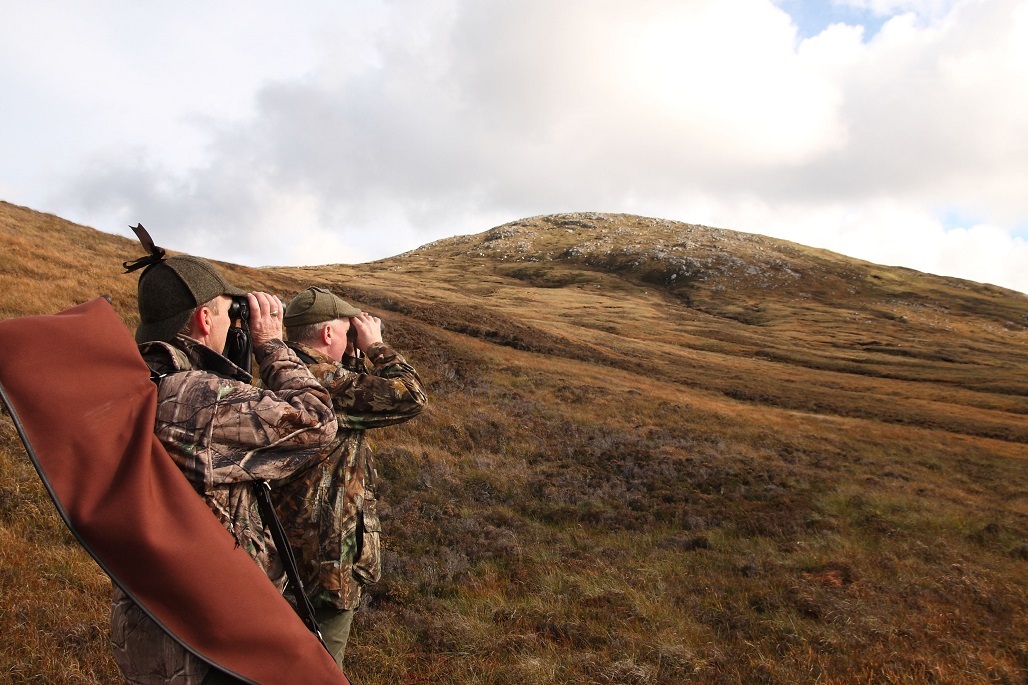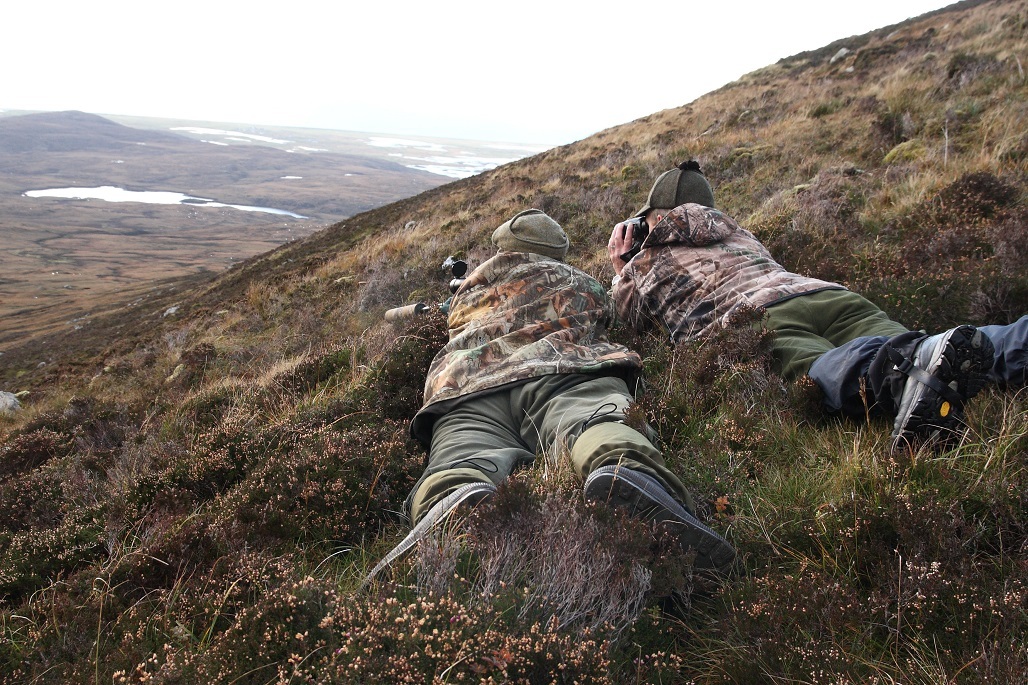
An exhilarating stalk on Uist still needs traditional skills
Alistair Matheson, the Gaelic bard, once wrote in praise of Uist and its wildlife.
‘Thugaibh leam le uaill gu fonnmhor,
Oran,s fonn do thir mo ghraidh,
Uibhist riomhach nan damh donn’
‘Come with me with pride and cheer,
With music and song to the land of my heart,
Bonnie Uist of the red deer’
Considering almost 100 years or so has passed since these words would have been penned, not much has changed in this land of plenty, or has it?
The Victorian sportsmen of the late 1800s were discovering the vast and rich sporting potential of the Highlands and Islands, none more so than in the Uists and Benbecula. Rail links from the south to the Highlands were established and every year many made the journey north and onwards across the Minch.

All set to go stalking on Uist
A remaining legacy of this was until very recently apparent in South Uist, where the land and sporting rights were owned and enjoyed by a UK-wide syndicate. However, that all changed with the advent of community buy-outs, the first of which was at Assynt on the north mainland in 1992. In 2006, South Uist and Benbecula followed suit, with the community voting unanimously to manage their own destiny.
They now come under the banner of Storas Uibhist (Wealth of Uist) the management body, and have been working tirelessly to consolidate the massive sporting potential, with that of a feasible and sustainable business plan. The land covers 95,000 acres and is a fabulous contrast of fertile lush machair running down to meet the Atlantic along its entire western coastline, to that of the east coast, with its rugged hill tops and glens, very similar to that of the west coast mainland. The focal point for sporting parties is Grogarry Lodge, the jewel in the crown for Storas, where guests are fed and watered with local produce of the highest standard.
I was delighted to be able to accompany native islander Rory MacGillivray, the recently appointed head of fish and game, in wonderful surroundings, exploring the high tops of Beinn Mhor and Hecla in search of a red stag. Our rifle was another local sportsman, Angus Campbell.
The views from the summit tops were magnificent; the lochs away to the west were shimmering in the October sunlight, and all around us was a mad, wild chorus of roaring stags.
The sporting season in Uist starts in early May, with the exceptional brown trout fishing, both in the rich and calceous machair lochs, and the numerous hill lochs. This is followed by the sea trout and salmon season, initially within the sea pools, and later when they enter the lochs. Geese, ducks, woodcock and on good years, exceptional snipe, abound.

The stalkers look for a stag
The one point of controversy that exists however, is the ever increasing numbers of grey lag geese. In 1980 it was estimated that a few pairs of geese were resident within South Uist and Benbecula, now that figure has risen dramatically to over 6,500 despite constant shooting and other conservation efforts. These include egg oiling, scaring and early season pair shooting.
‘Over the last ten years, there have been various funded plans to bring the increasing goose numbers under control, but in my opinion it’s a long term plan that’s required as they are considerably wiser than most would believe,’ said Rory. ‘The shooting and fishing parties that come to Grogarry Lodge always enjoy a few goose flights before breakfast then head out onto the lochs. There’s something about a skein of geese that swing in your direction and then, as that line comes closer, will they or won’t they come in range … it gets the heart racing.’
Our stalk wove an intricate path between boulders, gullies, and heathery saddles; most of our time being taken up avoiding huge master stags much too valuable to kill. It appeared almost that we were playing a complicated game of chess with testosterone-charged opponents on one side, and us mere mortals on the other.
However majestic these beasts are on the hill, they come under closer scrutiny during winter and early spring, when they appear from the tops and maraud around the valuable crops on the machair. The stalkers have a full-time job chasing them out almost daily, but unfortunately, some of the stubborn and returning animals have to be shot.
‘It really is a last resort to have to shoot them; this year we’ve managed to considerably reduce the number shot out of season, allowing us to increase the number of guest stalkers,’ said Rory. ‘It’s a fantastic place to stalk as you’ve seen from the heads we have; last season the average weight of stag shot by a guest was almost twenty stone.’

The stalkers at the firing point
An ear-splitting roar from the bottom of the glen brought us back to the job in hand, and after careful spying it was decided to try a stalk at the stag, some 600 yards below us. Rory led the way slowly downhill, with Angus in close attendance. The stalk became a crawl soon after and we all slid snake-like down through the rocks and heather. After what seemed like an age, we came to a halt, I watched the rifle being removed slowly from its cover and both stalkers slid forward to the firing point. The stag was in close attendance to his harem of hinds, some of which were only 40 yards away, but as is the nature of the game, he was careering back and forth, chasing off adversaries, and herding up his ladies.
We lay motionless for 20 minutes until the stag finally settled and gave Angus a clean shot. It was a magnificent beast. Rory later explained to us that he estimated it to be about 10 years of age, and although he had a narrow head, was a fine 15 pointer (a royal is a 10-pointer, an imperial has 14 points and a monarch 16). He was a wonderful trophy, and a most satisfying end to the day.
Later that evening within Grogarry Lodge we enjoyed a glass to celebrate, and reflected on the day. So much has changed since Alistair Matheson wrote his immortal words. Sportsmen and women from all parts of the globe can now enjoy all the islands have to offer, after first savouring the stalking prospects, and trout and salmon opportunities via their computer, without having to leave the office chair.
However, as amazing as that may be, just as in Matheson’s day, you still have to search and climb the hills to get your stag. No modern influences can aid you there.
As long as wild land such as the Uists exist, visitors will continue to explore and enjoy these unique places for ever. The islands will always remain the same, the deer and wildlife abound and proliferate, but the fine balance that must be achieved to allow both wildlife and land users to co-exist will cause land managers such as Rory MacGillivray many sleepless nights.
- This article originally appeared in Scottish Field magazine in 2016. The estate manager for South Uist is now Graeme Sinclair. For enquiries about stalking there, call 01878 700101.
TAGS

